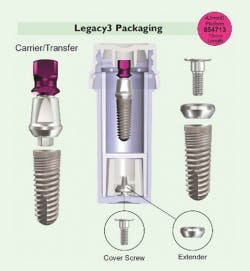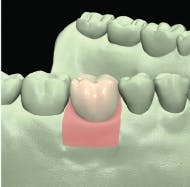The changing reality of the team approach to implant dentistry
by Gerald A. Niznick, DMD, MSD
For more on this topic, go to www.dentaleconomics.com and search using the following key words: implants, team approach, general dentistry, referrals, Dr. Gerald Niznick.
Editor's Note: This is the fourth in a four-part article covering the past, present, and future of dental implants and their impact on the practice of general dentistry. The final installment discusses how increased competition today has resulted in a need for surgical specialists to find out more about the restorative requirements of their referring dentists.The marketing dynamics within the dental implant industry are changing with regard to oral surgeons and periodontists growing or even maintaining their implant referral practices.General practice dentists, who have traditionally worked in the team approach to provide optimal treatment for their patients, are realizing that the most profitable way to participate in the implant revolution is to start placing implants. In some cases, this is encouraged by the same implant sales reps who help increase referrals to the surgical specialists who use their implant systems.
The salesperson who offers to increase referrals by providing "technical support" through abutment selection or training on impression procedures, may achieve this objective by directing referrals away from another surgical specialist who does not use that salesperson's implant system.
This pits one company's sales force against another and surgical specialists against each other in competition for implant-referring dentists. These same salespeople who help increase implant referrals to a surgical specialist can hold that specialist captive with the veiled threat of redirecting those referrals to another surgical specialist if one does not stay loyal to using that salesperson's system.
Surgical specialists find themselves victims of this shell game. They have to use three to four different implant systems to retain certain referring dentists and neutralize the threat of the salesperson switching to a surgical specialist more committed to that salesperson's system.
Through all this, the surgical specialist is unable to select the system that offers the best clinical results and value. The confusion in ordering surgical instruments, implants, and related components for three to four different systems is an expensive, and time-consuming problem.
Competition among surgical specialists for referrals is increasing, with some surgical specialists funding educational programs and study clubs. Many of the large implant practices were built by surgical specialists who assume an expanded role in the prosthetic phase. This includes buying and attaching abutments.
Some do this to capture some of the restorative fees at the expense of their referring dentists. Some general dentists take advanced training in bone grafting procedures to treat cases previously believed to be the domain of the specialist.
These "implantologists" may seek referrals from GPs for placing the implants, or even travel to dental offices to place implants, sharing the surgical fee on a percentage basis. This not only supplements the dental practice income, it reduces the surgical costs to the patients, and saves more of the patient's money for restorative procedures.
Another concern of surgical specialists is competition from corporate-sponsored implant "super centers" such as ClearChoice™, which is now in 20 U.S. cities. The company markets through TV commercials and full-page newspaper ads with celebrity endorsements. More general dentists also have expanded their marketing efforts for implant patients by advertising reduced prices. These create limitations on the fees of surgical specialists with a more informed public.
One answer for surgical specialists is to make implant dentistry easier and more profitable for their referring dentists, and more affordable for patients. All-in-1 implant packaging offers this solution.
Implant Direct's Legacy3 internal hex and ReActive internal trilobe implants are provided on fixture-mounts that can be shortened to serve as preparable abutments for cemented restorations. Given the wide variety of options for cemented restorations, sending the transfer/abutment to the dentist is often a wiser decision than the surgeon selecting and attaching the abutment. The key is to involve restorative doctors in the treatment planning, and to educate them on the selection of abutments since this will increase their commitment to working on a team with the surgeon.
This also reduces dependence on salespeople who may not have adequate knowledge. Implant Direct has developed a series of e-mail thank you letters for surgical specialists that include a link to prosthetic procedures specific for the implant system selected. Team communication is further enhanced by transferring the fixture-mount to the dentist via the implant vial, with platform-type and tooth number marked.
Article No. 1 in this series discussed the evolution of the internal connection implant introduced by the author in 1982, to the 2009 Legacy3 (shown above) in six diameters and five lengths. Article No. 2 described use of the ScrewIndirect and GoDirect one-piece implants for edentulous applications, which eliminates the need for the restorative dentist to buy and attach an abutment. Article No. 3 described the use of both one- and two-piece implants with prosthetic abutments for cemented restorations.
Increased competition dictates that surgical specialists learn more about the restorative requirements of their referring dentists, and choose a system that makes implant dentistry easier and more profitable for the team and patients.
Dr. Gerald Niznick graduated from the University of Manitoba Dental School in 1966 and then earned a master's degree in prosthodontics at Indiana University in 1968. He has been awarded 36 U.S. patents and received honorary doctorate degrees from the University of Manitoba and Tel Aviv University. Reach him at [email protected].




